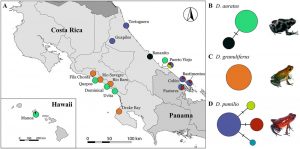With colleagues Andre Lourenco, Bernardo Antunes, and Guillermo Velo-Anton, Ian has a new paper out on “Fine-scale genetic structure in a salamander with two reproductive modes: Does reproductive mode affect dispersal?” in Evolutionary Ecology. This paper explores whether populations of fire salamanders (Salamandra salamandra) with different reproductive modes (larviparous vs. pueriparous) exhibit differences in patterns of dispersal and genetic structure over very fine spatial scales.
Lab News
5/25/18: Mike and Emma were awarded Lewis and Clark Exploration and Field Research Grants
Mike Yuan has received a grant from the Lewis and Clark Fund for Exploration and Field Research from the American Philosophical Society to support his field research in the Lesser Antilles.
4/6/18: Mike received a Grant in Aid of Research from Berkeley Sigma Xi
Mike Yuan has been awarded a Grant in Aid of Research from the Berkeley chapter of Sigma Xi. Mike’s award will support his work on parallel evolution and convergence in Anolis lizards.
4/2/18: Mike won a Student Research Award from the American Society of Naturalists
Mike Yuan has received a $2,000 Student Research Award from the American Society of Naturalists for his work on parallel evolution in Anolis lizards.
3/21/18: Mike has been awarded a Smithsonian Graduate Research Fellowship!
Mike Yuan has received a prestigious Graduate Student Research Fellowship from the Smithsonian Institution! The award will fund him to work at the National Museum of Natural History with Rayna Bell and Kevin de Queiroz for one year.
3/13/18: New paper on alkaloid resistance in poison frogs
We have a new paper on alkaloid resistance genes in poison frogs published in PLOS One. Motivated by the idea that if resistance is costly to maintain then we could expect it to be lost in low toxicity populations, we examined individual variation in a major alkaloid resistance gene in three species of poison frogs (Dendrobates auratus, D. granuliferus, and D. pumilio).
Yuan M.L. and Wang I.J. (2018) Sodium ion channel alkaloid resistance does not vary with toxicity in aposematic Dendrobates poison frogs: an examination of correlated trait evolution. PLOS One, 13: e0194265. doi: 10.1371/journal.pone.0194265

2/1/18: New NSF postdoc fellow Matt McElroy has joined the lab
We have a new postdoc this week – Matt McElroy has started a postdoc in the lab. Matt worked with Adam Leache at the University of Washington for his Ph.D. and received an NSF Postdoctoral Fellowship in museum collections research to come to Berkeley.
1/9/18: Mike’s talk at SICB featured on Anole Annals
Mike Yuan gave a great talk on Comparative Claw Morphology Across Anolis Lizards at the Society for Integrative and Comparative Biology (SICB) meeting last week. He examined over 500 specimens from 55 species, including all six ecomorphs, and a write-up of his talk is now available on the Anole Annals blog.
12/16/17: New review on space-for-time substitution and microevolutionary processes
Guin and Ian have a new review paper out in Ecography on how and when to use space-for-time substitution to study microevolutionary processes at fine spatial and temporal scales.
Wogan G.O.U. and Wang I.J. (2018) The value of space-for-time substitution for studying fine-scale microevolutionary processes. Ecography.
12/12/17: New paper on community assembly in soil fungi – IBE not IBD
Ian has a new paper out in Molecular Ecology, in collaboration with Sydney Glassman and Tom Bruns, on the factors driving community assembly in soil fungi at fine spatial scales. Using generalized dissimilarity modeling, this study shows that environmental filtering, rather than dispersal limitation, explains variation in fungal communities. The data were collected from the Gaylor Lakes basin in Yosemite National Park.
Glassman S.I., Wang I.J., and Bruns T.D. (2017) Environmental filtering by pH and soil nutrients drives community assembly in fungi at fine spatial scales. Molecular Ecology, 26: 6960-6973.
